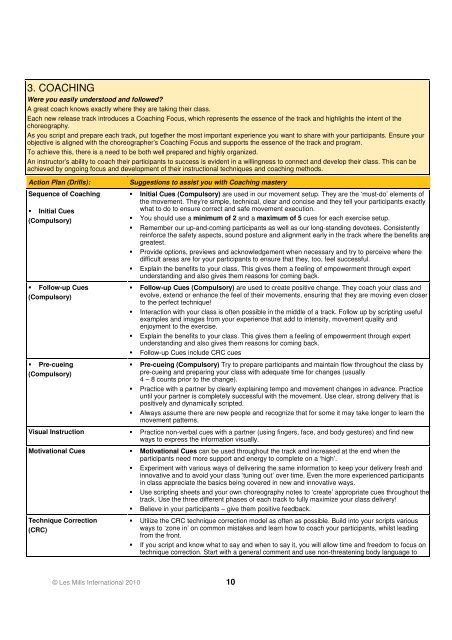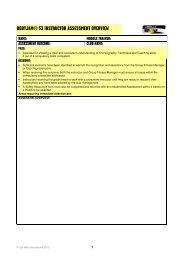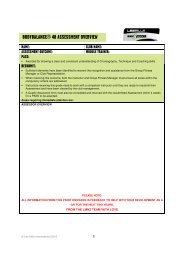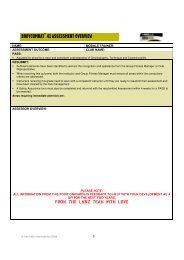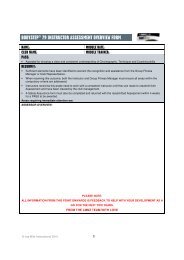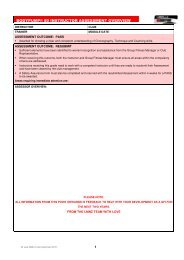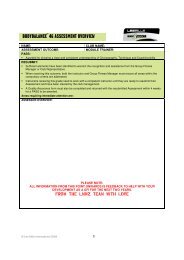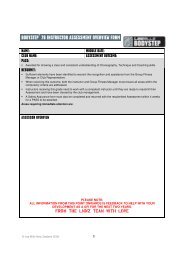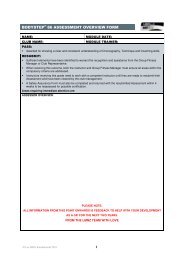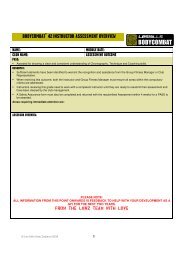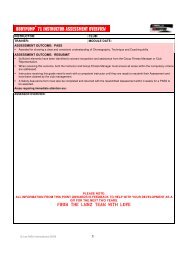bodyattack® 68 instructor assessment overview - Les Mills
bodyattack® 68 instructor assessment overview - Les Mills
bodyattack® 68 instructor assessment overview - Les Mills
You also want an ePaper? Increase the reach of your titles
YUMPU automatically turns print PDFs into web optimized ePapers that Google loves.
3. COACHINGWere you easily understood and followed?A great coach knows exactly where they are taking their class.Each new release track introduces a Coaching Focus, which represents the essence of the track and highlights the intent of thechoreography.As you script and prepare each track, put together the most important experience you want to share with your participants. Ensure yourobjective is aligned with the choreographer’s Coaching Focus and supports the essence of the track and program.To achieve this, there is a need to be both well prepared and highly organized.An <strong>instructor</strong>’s ability to coach their participants to success is evident in a willingness to connect and develop their class. This can beachieved by ongoing focus and development of their instructional techniques and coaching methods.Action Plan (Drills):Sequence of Coaching Initial Cues(Compulsory) Follow-up Cues(Compulsory) Pre-cueing(Compulsory)Suggestions to assist you with Coaching masteryInitial Cues (Compulsory) are used in our movement setup. They are the ‘must-do’ elements ofthe movement. They’re simple, technical, clear and concise and they tell your participants exactlywhat to do to ensure correct and safe movement execution.You should use a minimum of 2 and a maximum of 5 cues for each exercise setup.Remember our up-and-coming participants as well as our long-standing devotees. Consistentlyreinforce the safety aspects, sound posture and alignment early in the track where the benefits aregreatest.Provide options, previews and acknowledgement when necessary and try to perceive where thedifficult areas are for your participants to ensure that they, too, feel successful.Explain the benefits to your class. This gives them a feeling of empowerment through expertunderstanding and also gives them reasons for coming back.Follow-up Cues (Compulsory) are used to create positive change. They coach your class andevolve, extend or enhance the feel of their movements, ensuring that they are moving even closerto the perfect technique!Interaction with your class is often possible in the middle of a track. Follow up by scripting usefulexamples and images from your experience that add to intensity, movement quality andenjoyment to the exercise.Explain the benefits to your class. This gives them a feeling of empowerment through expertunderstanding and also gives them reasons for coming back.Follow-up Cues include CRC cuesPre-cueing (Compulsory) Try to prepare participants and maintain flow throughout the class bypre-cueing and preparing your class with adequate time for changes (usually4 – 8 counts prior to the change).Practice with a partner by clearly explaining tempo and movement changes in advance. Practiceuntil your partner is completely successful with the movement. Use clear, strong delivery that ispositively and dynamically scripted.Always assume there are new people and recognize that for some it may take longer to learn themovement patterns.Visual Instruction Practice non-verbal cues with a partner (using fingers, face, and body gestures) and find newways to express the information visually.Motivational Cues Motivational Cues can be used throughout the track and increased at the end when theparticipants need more support and energy to complete on a ‘high’. Experiment with various ways of delivering the same information to keep your delivery fresh andinnovative and to avoid your class ‘tuning out’ over time. Even the more experienced participantsin class appreciate the basics being covered in new and innovative ways. Use scripting sheets and your own choreography notes to ‘create’ appropriate cues throughout thetrack. Use the three different phases of each track to fully maximize your class delivery! Believe in your participants – give them positive feedback.Technique Correction(CRC)Utilize the CRC technique correction model as often as possible. Build into your scripts variousways to ‘zone in’ on common mistakes and learn how to coach your participants, whilst leadingfrom the front.If you script and know what to say and when to say it, you will allow time and freedom to focus ontechnique correction. Start with a general comment and use non-threatening body language to© <strong>Les</strong> <strong>Mills</strong> International 2010 10


